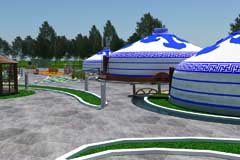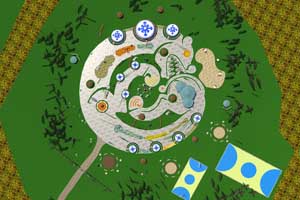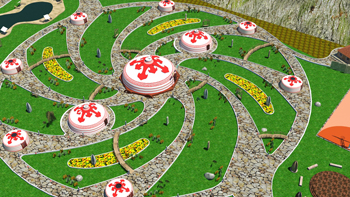|
 Two yurt-towns, “Mongun-Bulak” (Silver water spring) and “Aldyn-Bulak” (Golden water spring) will be built in Tuva this year, which was declared to be the Year of Tourism in the republic. Two yurt-towns, “Mongun-Bulak” (Silver water spring) and “Aldyn-Bulak” (Golden water spring) will be built in Tuva this year, which was declared to be the Year of Tourism in the republic.
The head of the republic, Sholban Kara-ool, announced this in an interview with local journalists on the eve of New Year.
The presentation of the project of the ministry of culture and tourism of RT took place on January 20. The project involves two yurt complexes intended as stationary campings for travelers. Each of the complexes will consist of a yurt-restaurant, two or three VIP-yurts, and several economy-class yurts. The complex will also have five reindeer-herder chooms with hearths, a sports-area, toilets, Russian bath – sauna, administrative buildings and vehicle parking area.
 These new complexes, in contrast to ordinary camps, will have more living amenities. They will be equipped with sanitation and septic tanks, there will be a system of water-supply and canalization, they will have their own electricity supply. The administrative buildings will house souvenir sale areas, kitchen, dining-room and the service personnel. These new complexes, in contrast to ordinary camps, will have more living amenities. They will be equipped with sanitation and septic tanks, there will be a system of water-supply and canalization, they will have their own electricity supply. The administrative buildings will house souvenir sale areas, kitchen, dining-room and the service personnel.
The largest, the yurt-restaurant, is calculated for 100 seating places. The diameter is 15 meters, the walls will be 3 meters high, and the total height of the yurt will be 5 meters.
The floor will be paved, and covered with carpeting. The de-luxe yurts will be made on speial order.
The economy-class yurts are calculated for 5 persons,, and represent, in their dimensions and furnishings, copies of traditional dwellings of Tuvan shepherds, just as they are still utilized by them. The chooms, aside from their educational role, will also serve as yet another exotic lodging for tourists. Those who will want to sleep in them will be issued sleeping bags of sheep wool.
The design of the camping complexes is also executed in ethnic style. The town “Mongun-Bulak”, for example, is planned in the for of the famous archeological find from the kurgan Arzhaan-1 – the Scythian pendant in the image of a curled-up panther. The second camping, “Aldyn-Bulak” in aerial view recalls a diagram of the Universe, and the yurts are distributed like the planets. For the roads, walkways, and other exterior structures of these tourist bases, the designers plan to use natural local sandstone – it is ecological, beautiful, and much less expensive in comparison with other materials.
 The interior design of the yurts, is, in a way, a mini-museum of Tuvan material culture. It is based on the elements of traditional existence of nomads, from Scythian times to contemporary arats – cattle herders. The interior design of the yurts, is, in a way, a mini-museum of Tuvan material culture. It is based on the elements of traditional existence of nomads, from Scythian times to contemporary arats – cattle herders.
The maximum capacity of each complex, according to the calculation of the authors of the project, is 60 people per day. The stays will be organized in tours of 6, 10, or 14 days. The tour would include food, lodging, and cultural programs. As auxiliary paid services, organization of excursions, as well as workshops in throat-singing, archery, and free-fighting are under consideration.
The cost of a six-day stay varies from 9 to 18 thousand rubles, depending on the class of the lodging. The necessary investments are around 18 million rubles. With the projected influx of about 3000 tourists each season, the campings should pay for themselves in about 4 years, as the specialists calculated.
As the minister of culture and tourism, Vyacheslav Dongak explained, this presentation of the project at the Ministry of Economics of the republic is just a preliminary evaluation of one of the possible variants. But in principle, the idea of creating yurt campings has already been approved by the head of the republic, Sholban Kara-ool, on the condition that the exotica will be accompanied by a high level of quality of the infrastructure of this type of tourist base, no worse than in Europe, and high quality of services.
The manufacturing base for the organization of tourist industry with local materials already exists. In one of the district centers of Tuva, a manufacture shop for making yurts opened last month. The order for making the traditional dwellings for the two complexes is planned to be realized here, and also in shops of folk industries, who make furniture and interior furnishings for nomadic arats – cattle-herders.
In the words of Chechena Ondar, an employee of ministry of culture and tourism, the authors of the project researched the wishes of the visitors to the republic, before they started the work. As became clear, russiam and so much more foreign tourists are not impressed by fashionable hotels anymore, or log cabin bungalows of the hunting lodge type, or other usual stationary bases. Besides that, they are expensive to maintain off-seazon or when the influx of visitors drops dramatically.
 These yurt campings appear to be an ideal solution under the conditions of sharp seasonality of tourism in Tuva, the ministry believes. It is enough to build and equip the summer yurt-town complexes with the necessary networks. When winter comes, and the stream of travelers drops off, it is a matter of two or three days to wrap up the yurt camp and take it away for storage until the next season. These yurt campings appear to be an ideal solution under the conditions of sharp seasonality of tourism in Tuva, the ministry believes. It is enough to build and equip the summer yurt-town complexes with the necessary networks. When winter comes, and the stream of travelers drops off, it is a matter of two or three days to wrap up the yurt camp and take it away for storage until the next season.
The idea is especially suitable for the encouragement of automobile tourism, which is becoming more popular in Tuva every year. We can say that the participants of the Tuva trophy-expedition in this January from the Novosibirsk club Off Road Master were enthusiastic about the idea of such camps. They could be not just a place to spend the night for automobile tourists, but also to learn about the ancient culture of the nomads, which is centered around their dwelling – the felt yurt.
|
|
